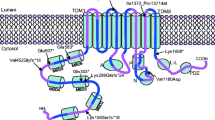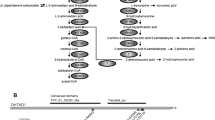Summary
We examined the molecular basis of adenine phosphoribosyltransferase (APRT) deficiency in homozygous-deficient, identical twin brothers who were born to non-consanguineous German parents. DNA was isolated from blood, and the APRT gene was amplified by PCR, subcloned into M13, and sequenced completely. A single T insertion between bases 1831–1832 or 1832–1833 was identified. This alters the consensus sequence at the exon 4 — intron 4 splice donor site and leads to aberrant splicing. The same mutation has been described previously in two affected brothers from Belgium, and the Indianapolis group has also identified it in two other, unrelated Caucasian patients. Thus, this mutation may be a common cause of APRT deficiency in the Caucasian population.
Similar content being viewed by others
Abbreviations
- APRT:
-
adenine phosphoribosyltransferase
- DHA:
-
2,8-dihydroxyadenine
- PCR:
-
polymerase chain reaction
- PP-ribose-P:
-
5-phosphoribosyl-1-pyrophosphate
- RFLP:
-
restriction fragment length polymorphism
References
Arrand JE, Murray AM, Spurr N (1987)Sph I restriction fragment length polymorphism on human chromosome 16 detected with anAPRT gene probe. Nucl Acid Res 15:9615
Carothers AM, Urlaub G, Mucha J, Harvey RB, Chasin LA, Grunberger D (1990) Splicing mutations in the CHODHFR gene preferentially induced by (+/−)-3 alpha, 4 beta-dihydroxy-1 alpha, 2 alpha-epoxy-1,2,3,4-tetrahydro-benzo[c]phenanthrene. Proc Natl Acad Sci USA 87:5464–5468
Chen J, Sahota AS, Stambrook PJ, Tischfield JA (1991) Polymerase chain reaction amplification and sequence analysis of human mutant adenine phosphoribosyltransferase genes: the nature and frequency of errors caused by Taq DNA polymerase. Mutat Res 249:169–176
Chen J, Sahota AS, Stambrook PJ, Tischfield JA (1991) Hot spots for germline and in vivo somatic mutations in a human autosomal gene. Science (in press)
Hesse A, Miersch W-D, Classen A, Thon A, Doppler W (1988) 2,8-Dihydroxyadenuria: laboratory diagnosis and therapy control. Urol Int 43:174–178
Hidaka Y, Pallela TD, O'Toole TE, Tarlé SA, Kelley WN (1987) Human adenine phosphoribosyltransferase. Identification of allelic mutations at the nucleotide level as a cause of complete deficiency of the enzyme. J Clin Invest 80:1409–1415
Hidaka Y, Tarlé SA, Fujimori S, Kamatani N, Kelley WN, Pallela TD (1988) Human adenine phosphoribosyltransferase deficiency: demonstration of a single mutant allele common to the Japanese. J Clin Invest 81:945–950
Hönecke K, Butz M (1989) 2,8-Dihydroxyadeninharnstein: Die Bedeutung der exakten physikalischen Steinanalyse. Urologe 28:361–362
Jung P, Becht E, Ziegler M, Bommert R, Bach K, Haas HJ (1988) New diagnostic and therapeutic aspects of 2,8-dihydroxyadenine lithiasis. Eur Urol 14:493–497
Kamatani N, Kuroshima S, Hakoda M, Pallela TD, Hidaka Y (1990) Crossovers within a short DNA sequence indicate a long evolutionary history of theAPRT * J mutation. Hum Genet 85:600–604
Murray JAH (1986) HCC ligation: rapid and specific DNA construction with blunt ended DNA fragments. Nuc Acids Res 14:10118
Ogasawara N, Goto H (1989) Restriction fragment length polymorphism ofHPRT andAPRT genes in Japanese population. Adv Exp Biol Med 253A:461–465
Sahota AS, Chen J, Stambrook PJ, Tischfield JA (1991) Mutational basis of adenine phosphoribosyltransferase deficency. Int J Pur Pyr Res 2, Suppl 1:83
Simmonds HA, Sahota AS, Van Acker KJ (1989) Adenine Phosphoribosyltransferase deficiency and 2,8-dihydroxadenine lithiasis. In: Scriver CR, Beaudet AL, Sly WS, Valle D (eds) The metabolic basis of inherited disease, 6th edn. McGraw Hill, New York, pp 1029–1044
Stambrook PJ, Dush MK, Trill JJ, Tischfield JA (1984) Cloning of a functional human adenine phosphoribosyltransferase (APRT) gene: identification of restriction fragment length polymorphism and preliminary analysis of DNAs from APRT-deficient families and cell mutants. Som Cell Mol Genet 10:359–367
Tischfield JA, Chen J, Stambrook PJ (1990) Wither APRT? Molecular Biology of APRT Conference, Indiana University, Bloomington, Ind., USA (abstract 16)
Zöllner N, Gresser U (1990) Nephrolithiasis in twins with APRT deficiency. Stones as a marker of an inborn error of metabolism. Bildgebung/Imaging 57:64–66
Author information
Authors and Affiliations
Rights and permissions
About this article
Cite this article
Gathof, B.S., Sahota, A., Gresser, U. et al. Identification of a splice mutation at the adenine phosphoribosyltransferase locus in a German family. Klin Wochenschr 69, 1152–1155 (1991). https://doi.org/10.1007/BF01815434
Received:
Revised:
Accepted:
Issue Date:
DOI: https://doi.org/10.1007/BF01815434




